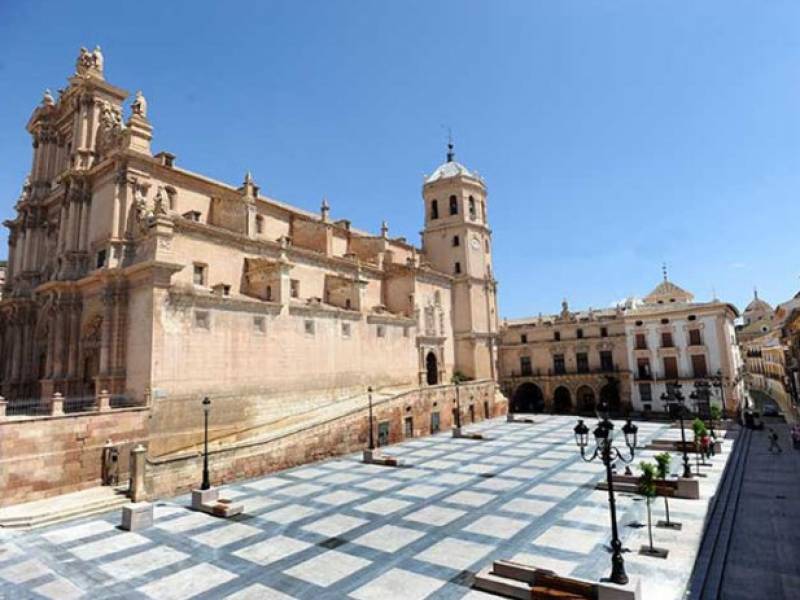-



 Welcome To
Welcome To
 Visit Lorca Castle.Click Here
Visit Lorca Castle.Click Here
To Pre Book
Tours & Activities -



 Welcome To
Welcome To
 The Embroidery Museums.Click Here
The Embroidery Museums.Click Here
To Arrange
Your Visit!












 Route name: El Casco Antiguo de Lorca 2023
Route name: El Casco Antiguo de Lorca 2023
Lorca is a city rich in history, its strategic position above the Guadalentín Valley having attracted human settlers for thousands of years. The municipal archaeological museum shows a wide selection of artifacts dating back into prehistory, tracing the various settlements which left remains in Lorca: The Argarics, Iberians, Moors, Jews and Christians. The imposing medieval castle dominates the skyline, the 15th-century Jewish synagogue just below it still survives intact, and the city at its foot filled with ornate Baroque buildings.
On this tour an official regional tour guide shows visitors the most important historical buildings in the old quarter of central Lorca, including those in the Plaza de España and the Plaza del Caño, such as the Ayuntamiento, the ex-Collegiate Church of San Patricio and the Casa del Artesano.
The tour is in Spanish, but there is plenty to see, leaflets are available in English from the tourist office, and once armed with a map and this basic orientation, the city can be revisited at any time and the locations explored at leisure.
The 90-minute visit leaves from outside the Tourist information point in the Plaza de España at 17.00, and booking is essential as places are limited, so contact the Tourist Office if you’d like to go or book directly using the booking system which can be found here.
(N.B. The tourist office is able to arrange English-language tours for groups by prior arrangement and offers this visit in English from time to time: see the What’s on section of Lorca Today for scheduled dates).
For more information about what to see, what to do and where to eat and drink in Lorca visit the home page of Lorca Today.

The rich and extensive history of Lorca has left a legacy of archaeological sites, and historic buildings, around which the modern City has built its tourism industry. Amongst these are Lorca Castle, the Jewish Quarter of the castle and Synagogue,  Plaza de España, Colegiata de San Patricio, Museo de Arqueologico Municipal, Iglesia de San Francisco, Casa Huerto Ruano, Palacio de Guevara, Iglesia de San Mateo, Pósito de los Panaderos, Convento Virgen de las Huertas, Antiguo Convento de la Merced, Iglesia del Carmen and the Teatro Guerra.
Plaza de España, Colegiata de San Patricio, Museo de Arqueologico Municipal, Iglesia de San Francisco, Casa Huerto Ruano, Palacio de Guevara, Iglesia de San Mateo, Pósito de los Panaderos, Convento Virgen de las Huertas, Antiguo Convento de la Merced, Iglesia del Carmen and the Teatro Guerra.
Unfortunately Lorca has also been prone to natural disaster, suffering a Gota Fría on September 28th 2012, as well as an earthquake which measured 5.3 on the Richter scale on 11th May 2011 and claimed 9 lives. Since this earthquake the city has been rebuilding, winning recognition for its Lorca, Open for Restoration initiative, which used the restoration of the city as a tourist attraction whilst it rebuilt its historical buildings, some of which are currently still not open.
 The tourist office itself has temporarily relocated until the renovations are completed and is on Calle San Patricio near the church.
The tourist office itself has temporarily relocated until the renovations are completed and is on Calle San Patricio near the church.
Lorca also has an area of coastline incorporating the Parque Regional de Cabo Cope - Puntas de Calnegre, in the Sierra de Almenara, which includes the beaches of, Puntas de Calnegre, Baño de las Mujeres, San  Pedro, El Siscal, Cala Honda, Cuartel del Ciscar, Junquera, Cala de la Gruta, Cala Leña, Los Hierros, Cala Blanca and Playa Larga, although many are accessible only through agricultural exploitations.
Pedro, El Siscal, Cala Honda, Cuartel del Ciscar, Junquera, Cala de la Gruta, Cala Leña, Los Hierros, Cala Blanca and Playa Larga, although many are accessible only through agricultural exploitations.
However, in spite of its many attractions, the name of Lorca is synonymous with Easter, (Semana Santa) its biblical parades of International Tourist Interest status and famous throughout Spain. The week includes a  series of parades in which the whites (Paso Blanco) and blues (Paso Azúl) try to outdo each other with the magnificence of their embroideries and the skill and daring of their horsemen.
series of parades in which the whites (Paso Blanco) and blues (Paso Azúl) try to outdo each other with the magnificence of their embroideries and the skill and daring of their horsemen.
Lorca also has a Parador hotel, located within the complex of its historic castle.
For more local news, events and visiting information go to the home page of Lorca Today



Hello, and thank you for choosing CamposolToday.com to publicise your organisation’s info or event.
Camposol Today is a website set up by Murcia Today specifically for residents of the urbanisation in Southwest Murcia, providing news and information on what’s happening in the local area, which is the largest English-speaking expat area in the Region of Murcia.
When submitting text to be included on Camposol Today, please abide by the following guidelines so we can upload your article as swiftly as possible:
Send an email to editor@camposoltoday.com or contact@murciatoday.com
Attach the information in a Word Document or Google Doc
Include all relevant points, including:
Who is the organisation running the event?
Where is it happening?
When?
How much does it cost?
Is it necessary to book beforehand, or can people just show up on the day?
…but try not to exceed 300 words
Also attach a photo to illustrate your article, no more than 100kb
